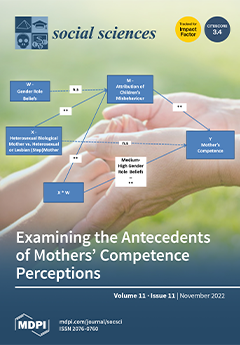Delinquency in adolescence is rooted in a complex multifaceted system that comprises several factors such as personal characteristics, family, school, peers, and community, all of which are embedded in the sociocultural context in which they are present. There is a paucity of research
[...] Read more.
Delinquency in adolescence is rooted in a complex multifaceted system that comprises several factors such as personal characteristics, family, school, peers, and community, all of which are embedded in the sociocultural context in which they are present. There is a paucity of research on juvenile delinquency and its risk factors across many regions, especially low- and middle-income countries, including Arab countries. This study aimed to develop an understanding of the personal, familial, and behavioral characteristics of Arab juvenile delinquents in the distinctive sociocultural context of Jordan. All juveniles who were incarcerated at the time of data collection (N = 197) were targeted using a convenience sampling approach from a total of 11 juvenile rehabilitation centers distributed over the northern, middle, and southern regions of the country. Anonymous surveys were used to collect data on juvenile delinquents’ personal, familial, psychosocial, and behavioral characteristics. A total of 186 juvenile delinquents completed the study questionnaire (9.7% females). About 52% were not attending school regularly, 32% had divorced, separated, or deceased parents, 6% reported receiving a diagnosis of mental illness, and 91% reported they never sought psychological support of any kind. Regarding substance consumption, 70% were smokers, 26% were alcohol consumers, and 15% were on drugs. About 12% spent more than 7 h on their cellphones, and 43% reported dedicating no time for physical activity. Theft was the most frequently reported offense (35%), followed by quarreling with peers (25%), and possession of drugs (9%). Approximately 42% reported that their friends encouraged them to cause trouble, while the majority (74%) reported that their school had no positive or negative influence on their behavior. Several behavioral problems were detected, with females showing significantly higher scores in impulsivity, inattention, emotional lability, and social problems compared to their male counterparts. Severity of the conduct problems was negatively associated with the length of engagement in physical activities, while both impulsivity and inattention scores were positively associated with the length of engagement in watching TV and using cellphones (all
p < 0.05). Overall, these juvenile delinquents have unsatisfactory academic and schooling experiences, engage in unhealthy lifestyles and exhibit several behavioral problems. Differences in juvenile delinquency risk factors across different sociocultural contexts can influence prevention efforts. Comprehensive prevention strategies that reduce risk and develop protective factors need to target juveniles early in their development and consider factors related to their families, schools, peers, and communities.
Full article





